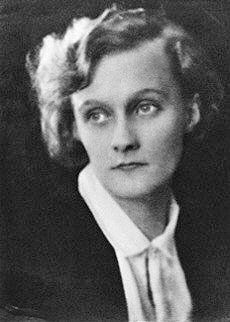Title of the work
Country of the First Edition
Country/countries of popularity
Original Language
First Edition Date
First Edition Details
Astrid Lindgren, Ronja rövardotter. Stockholm: Rabén & Sjögren, 1981, 235 pp.
ISBN
Genre
Action and adventure fiction
Bildungsromans (Coming-of-age fiction)
Fantasy fiction
Novels
Target Audience
Crossover (Children nad Young adults)
Cover

We are still trying to obtain permission for posting the original cover.
Author of the Entry:
Allison White, University of New England, awhite55@une.edu.au
Peer-reviewer of the Entry:
Elizabeth Hale, University of New England, ehale@une.edu.au
Lisa Maurice, Bar-Ilan University, lisa.maurice@biu.ac.il

Retrieved from Wikipedia Commons, public domain (accessed: December 8, 2021).
Astrid Lindgren
, 1907 - 2002
(Author)
Astrid Lindgren was a Swedish author, most popularly known for her series of books about Pippi Longstocking. Lindgren grew up in Vimmerby, Småland, but afterwards moved to Stockholm and worked at the Royal Automobile Club as a secretary. After the publication of Pippi Longstocking in 1945 by Rabén & Sjögren, Lindgren worked at the publishing company as an editor and was afterwards responsible for the publication of children’s books. Lindgren was active in political matters, including speaking against the cruel treatment of animals, and the use of nuclear power. In 1978 she was awarded the German Book Trader’s Peace Prize and at the ceremony gave a speech against the use of corporal punishment in child-rearing. Lindgren had two children, Lars and Karin, and lived the remainder of her life in Stockholm.
Source:
Official website (accessed: June 27, 2018).
Bio prepared by Allison White, University of New England, awhite55@une.edu.au
Adaptations
Ronja, The Robber’s Daughter (Animated Series, 2014);
Ronja Räubertochter (Musical, 1994);
Ronia, The Robber’s Daughter (Film, 1984).
Translation
Translated into at least 37 other languages.
Summary
An adventure-fantasy story for young readers reflecting the tale of Pyramus and Thisbe. Ronia, The Robber’s Daughter by Astrid Lindgren takes place in an imaginary wood in Sweden known as Matt’s Forest where there are harpies, goblinfolk, Unearthly ones and gray dwarves. The protagonist, Ronia, is born in a robber’s stronghold and soon learns how to traverse Matt’s Mountain and avoid the hell-harpies (who would tear up their victims or enslave them). On the night of her birth there was a great storm and a bolt of lightning broke the Robber’s stronghold in two, leaving a gaping hole known as ‘Hell’s Gap’ in the darkest part of the fort. The enemy ‘Borka’ robbers then move in to the other side of the stronghold. As Ronia grows up, she discovers that there is a boy, Birk, on the other side of Hell’s Gap, who belongs to the rival robber enemy of her father, Borka. Ronia and Birk soon become friends, each saving the other’s life, and decide that they wish to be brother and sister. This enrages Ronia’s father, Matt, and when she chooses to be with Birk, Matt disowns her as his daughter. Ronia and Birk then go to live together in ‘Bear’s Cave’ deep in the forest and learn how to fend for themselves. When winter comes, Matt asks Ronia to come home and she agrees, but only until the spring comes again. Matt and Borka engage in a fight to establish who is to be the head chief over all the robbers. Matt wins the fight but allows Borka to remain chief over his own robbers and they soon become friends, allowing Ronia and Birk to remain together.
Analysis
An adventure-fantasy novel for young readers which has structural similarities to the story of Pyramus and Thisbe, set in a fantasy forest in Sweden. Ronia, The Robber’s Daughter has several parallels to the story of Pyramus and Thisbe as well as Romeo and Juliet: two people whose family will not allow them to be together, though it is unclear whether this is a direct adaption. This story alters the ending, arriving at a happy conclusion for Ronia and Birk as their two fathers learn to work together. Ronia and Birk are not lovers, but Lindgren instead creates their bond as brother and sister. There are hints of this being more than a familia relation, i.e. when Birk tells his mother that Ronia is her sister, his mother replies, Oh, yes, we know what that will mean in a year or two! (p. 97). There is a similarity between the innocent love of Ronia and Birk to that of Daphnis and Chloe, not knowing exactly what love is.
There are several mythological creatures, e.g. harpies, who fly around in the sky shrieking while they search for their prey. They reflect the Greek and Roman mythology of the harpies who are half bird and half human. The Unearthly ones lure their victims beneath the earth with their songs, reflecting the mythology of sirens as well as the Saxon will-o-the-wisp mythology (a light which would draw travellers away from the safe path). The inclusion of the mythological atmosphere indicates a loose reception of classical material.


